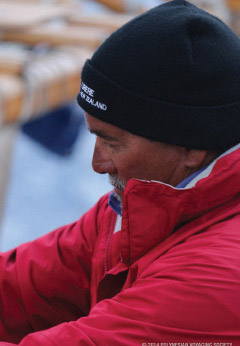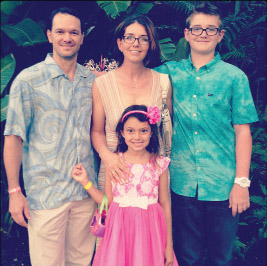
The Man Behind The Makery: Dr. Neil Scott
 By Le‘a Gleason
By Le‘a Gleason
There’s a saying that if you can dream it, you can build it. At Hilo’s The Makery, if you can build it, you can learn to make it. That’s way this new workshop-meets-art-gallery is one of inspiration, innovation, and empowerment.
New Zealand native Dr. Neil Scott set out to become a doctor, then after a year at a University, an unexpected turn of events led him to leave school to pursue his first love: electronics.
He went on to spend the next eight years gaining firsthand experience in the field.

“During [those] eight years I did night school and ‘real work.’ That’s what I feel is missing here in Hawai‘i. The community colleges in New Zealand prepare what is the middle of our economy. They’re the technicians and the food technologists and nurses…the occupations that keep the economy going,” he says.
At 28, Neil returned to college for an engineering degree. When he went back, he knew why he was there. Feeling a sense of purpose and helping inspire that in others would become a major theme in his life. In his mid-thirties, as head of the engineering department, he spent time helping design students learn the science and math behind their ideas which would make building them realistically feasible.
In the 70s, microprocessor technology was developing and Neil spent time teaching the general public how to use computer chips as tools for things like turning a light on and off.
“A few weeks later, I got a call asking ‘can you bring some of those things down to the annual general meeting of the crippled children’s society?’ They said, ‘we’ve got this little girl we don’t know what to do with,’ ” Neil says.
Neil had never seen disabled kids en masse before, and he remembers thinking weʻd put men on the moon yet still couldn’t do anything to help those kids.
When Neil met Jackie, he watched her therapists struggle to help her communicate.
“The thing about engineering is, you have to figure out what’s wrong and then you can fix it. So, I put my hand out [above her knee] and said, ‘can you hit my hand?’ I said to the staff, ‘we can teach her [to] send Morse code with her knee,’ and then I made her this little box,” Neil remembers.
He designed and built a computer system attached to a TV screen that would allow Jackie to communicate by hitting several triggers on a wooden box with her knee. When everyone gathered to watch her speak for the first time, her first words were this: N-e-i-l i-s o-k-a-y.
“I thought to myself ‘this little girl just spoke for the first time and she thinks I’m okay,’ so my life sort of did this big right angle turn,” Neil says.
He continued to work as an engineer, but found that no matter where he went, there was always an eventual pitter-patter of feet running up to him, a tap on the shoulder, and then a voice: “can you help my son/daughter?”
The first disabled adult Neil worked with was 35, fluent in five languages, and had traveled the world. Multiple sclerosis had left her lying on her back unable to communicate in any way except to blink.
After designing an eye-tracking computer system to help create written messages for people, he received a message saying: “Dear Neil, I’m pissed off at having no uppercase letters or numbers, because how can I write my book?”
“Things like that give you motivation big time…I just kept having experiences like that with people who were on a starvation diet and three weeks later were having home visits,” Neil says.
When a problem with import taxes made it difficult to continue on this path in New Zealand, Neil moved to San Francisco and hung up a sign that read: I know how to make computers work for kids.
He went on to work at California State University, Northridge using grant funding to create accommodations for disabled students and was later offered a job at Stanford, where he worked for 12 years doing research on human disabilities.
“[At Stanford] I met legendary people [who] wrote the books on engineering…there were halls named after the people who wrote the books I’d studied at University,” Neil says.
Then, a friend who worked at the University of Hawai‘i, Mānoa reached out. Again it was the same message: we’ve got a problem! Can you help?
This time the challenge was to keep graduates in Hawai‘i. Neil secured a grant from the National Science Foundation and created The Invention Factory.
“We got an inquiry from the job counselor at Sacred Hearts Academy, and the normal thing is you go and talk about [engineering], but we said, ‘let’s do something different. Let’s get some toys and teach them how to make them work for disabled kids.’ We did this one Saturday and about three weeks later, the phone calls came from schools all over O‘ahu. It went from that one event to once a month…[to] every Saturday,” Neil remembers.
He figured out a way to challenge kids by presenting them with a toy, and then having them make it work without typical capabilities like sight or touch. During the first year, they made toys work for disabled kids, and in the second year, they made appliances work for the elderly. In the third year, Neil felt it was time to offer the kids a bigger challenge.
“I took my steel guitar and said, ‘when I was your age I desperately wanted one of these, and the only way to get it was to make it.’ I said the difference was that my dad had a workshop, but since they were so into computers, I’d buy a little computer controlled machine and we’d teach it how to make the parts for the guitars,” Neil remembers.
Through The Invention Factory, 20 guitars were crafted in the first year. The kids were thrilled about what they’d made, but since the guitar bodies were so large, they’d had to outsource to someone with a larger machine who could cut the wood.
“This was the perfect way of getting them motivated. At the end, they said, ‘why can’t we build a machine where you don’t have to go to somebody else to make it?’ So I got another grant and came up with The Makery,” Neil says.
Today, The Makery stands on the corner of Kalakaua Street in Downtown Hilo. The concept for the space has grown out of Neil’s multiple passions; the desire to help the disabled; to help kids in general become capable and self-sufficient; and most importantly, to help all people learn that if they can dream something up, they can acquire the skills to build it themselves.
In a workshop behind the storefront space, large Computer Numerically Controlled (CNC) machines do most of the work. They operate through computer programs to administer commands based on designs. The result? Perfectly articulated steel lap guitars, just like the one Neil first built at 15.
More than 250 kids have built these guitars to date.
Today, the workshop is primarily in the production of steel lap guitars and koa wood urns. Starting off with these two marketable products is another part of Neil’s plan.
“So many of the organizations that are available to help people are struggling because their funding comes from somewhere else, so I want to see to it that [people] get involved in creating things that they can sell to make them self-sufficient, so it becomes normal that part of your business plan is ‘what are we going to be making and selling?’ My endgame for this was in five years I could step back and say this is a model resource for training and manufacturing that is driven by the community and is self-funded,” Neil says.
One person already making and selling his creations is 23-year-old Michael Nizo, who sustained a spinal injury driving off Hanalei Pier on Kaua‘i in 2004. Michael is a part of the Technology for Untapped Talent (TUT) program at The Makery and is responsible for the intricately designed wooden three-dimentional puzzles that sit in the gallery.
“Everyday I wake up and the first thing I think about is, ‘what am I going to make at The Makery?’” he says.
Joe Gimen is another TUT program member, who moved to Maui in 2006 in hopes of becoming an electrician. Two weeks before his interview, he fell down off a sidewalk, resulting in a spinal cord injury which left him paralyzed from the neck down. Joe is able to design intricate patterns using computer programs like Corel Draw using special tracking software that recognizes a dot on his glasses.
In the front-of-house, a gallery showcases the work made and sold at The Makery by its volunteers and employees, as well as work by other local artists.
Another retail element of the business is a custom frame shop where Neil hopes he’ll be able to train students to learn framing as a marketable skill.
“The group that is here has melded into this wonderful environment in terms of everyone finding their place and supporting each other. Everyone’s got this common goal of figuring out how to make this all work,” Neil says.
“We need food, water, and need to feel we’re part of something. We’ve got to make it possible for people who wouldn’t ordinarily be able to earn enough, to make a living. With these machines it becomes possible for them to make incredible things. What I see evolving is people coming through the door and saying, ‘this is a product I’ve got an idea for how can I make it?,’ ” he says.
Then, they team up. Neil provides the capital and the wisdom, and the other person is full of enthusiasm.
“I’ll give a scholarship to run the machine at one-fifth of its cost so they can start manufacturing a product, and if they make sales, they can pay another percent on the machines. Eventually, they can afford to have their own machine, and that’s when I say my part is done,” he says.
❖
For more information or to get involved call 808.933.8571, or visit The Makery either online or at 126 Keawe St., Hilo.


